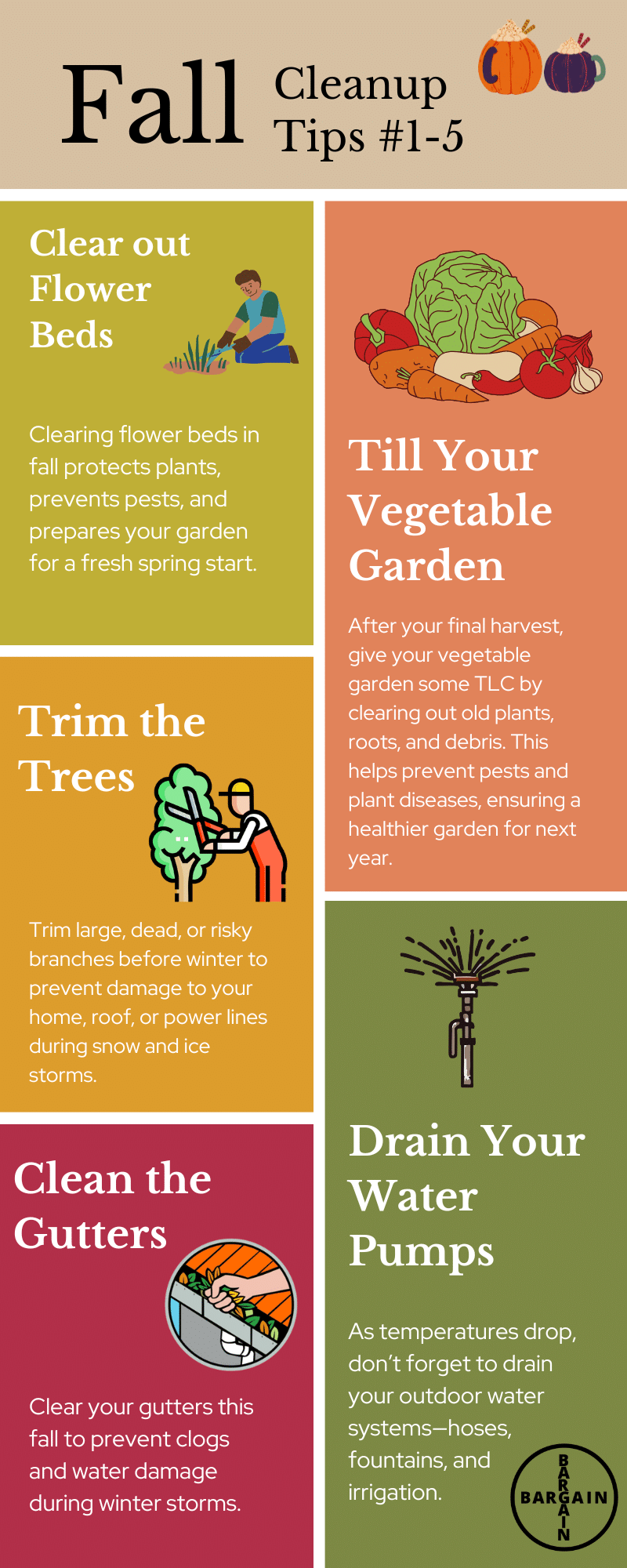10 Fall Yard Cleanup Tips for a Healthy Spring
As the leaves start to fall and the weather cools down, it’s time to give your yard extra attention before winter arrives. Fall yard cleanup isn’t just about keeping things looking nice—it’s about preparing your outdoor space to handle the colder months and setting it up to thrive come spring. Putting in a little effort you’ll prevent a lot of common winter damage and make spring gardening easier and more rewarding.
This guide has rounded up the top 10 essential fall yard cleanup tips. From clearing out flower beds to aerating the lawn, these tips will keep your yard healthy, organized, and ready to bounce back as soon as warmer days return. Let’s dig in and get your yard prepped for a beautiful new season!
Clear Out Flower Beds
Clearing out your flower beds in the fall might feel like a chore, but it’s one of the best ways to protect your plants and prevent pests from invading. Fallen leaves, weeds, and old plant debris can become a cozy hiding spot for critters, insects, and even plant diseases looking to settle in for the winter. By removing this clutter, you’re not only giving your flower beds a clean, fresh start for spring, but you’re also discouraging unwanted guests from making themselves at home.
Start by gently pulling out weeds and any dead plants, taking care not to disturb any perennials you want to keep. Then, rake out the fallen leaves and other debris to keep everything neat. If you like, you can add a layer of mulch to help insulate the soil and protect any roots from temperature swings.
Till Your Vegetable Garden
After you’ve enjoyed the last harvest of the season, it’s time to give your vegetable garden some TLC. Clearing out old plants is essential—leaving them in the ground can attract pests and spread plant diseases, which will make it tougher for new plants to thrive next year. So, go ahead and pull out those spent vegetable plants, making sure to remove any lingering roots or debris.
Once your garden beds are cleared, tilling the soil helps prepare it for a successful spring. This process breaks up compacted soil, making it easier for future roots to grow deep and strong. Tilling also aerates the soil, allowing essential nutrients, water, and oxygen to circulate more effectively. If you’ve got compost on hand, now’s a great time to mix it in, adding an extra nutrient boost that’ll keep your soil rich and ready for planting.
Trim the Trees
As we head into winter, it’s essential to check your trees for any large, dead, or awkwardly positioned branches. Trimming these now can save you major trouble once the snow and ice arrive. Winter weather adds extra weight to branches, and any weak ones near your home could snap and cause real problems. A falling branch might damage your roof, break a window, or, if it’s close to a power line, even lead to an outage during freezing temperatures—not something anyone wants to face in the dead of winter!
A good rule of thumb is to keep branches trimmed back a safe distance from your house and power lines. You can manage smaller branches on your own with a sturdy set of pruning shears, but if you’re dealing with large or high branches, it might be worth calling a professional.
Clean the Gutters
Gutters are the unsung heroes of our homes, channeling rainwater away from the foundation and preventing a whole host of potential issues. But fall can turn gutters into leafy, muddy messes, and if left alone, these clogs can cause water to overflow and damage both your home and yard. Taking some time now to clear out those gutters will make a huge difference when winter storms roll in.
Start by grabbing a sturdy ladder, a pair of gloves, and a small shovel or scoop. Clear out any leaves, sticks, and debris you find along the way. If you can, flush the gutters with a garden hose to check for blockages you might have missed. Once water flows smoothly through, you’ll know they’re good to go.
If the thought of gutter cleaning doesn’t thrill you (or you have a multi-story home), hiring a professional can be a smart investment. It’s well worth it to keep everything draining properly and avoid costly water damage down the road.
Drain Your Water Pumps
As the weather gets cooler, it’s time to give your outdoor water systems some attention. Draining your water pumps, including hoses, fountains, and irrigation systems, is a simple but essential task to avoid costly damage during the winter months.
Water left in these systems can freeze and expand, causing cracks or breaks that might not be obvious until spring. To protect your equipment, start by draining all the water from your hoses and any outdoor fountains or water features. Once drained, store them in a dry, sheltered place, like a garage or shed, to keep them safe from the cold.
Don’t forget about your irrigation system! If you have an automatic sprinkler system, it’s a good idea to blow out the lines to remove any water left behind. This will prevent freezing and ensure your system works perfectly come spring.
Aerate Your Yard
Aerating your yard is an essential step to ensure your lawn and garden stay healthy throughout the winter and thrive when spring arrives. Over time, soil can become compacted from foot traffic, weather conditions, and lawn equipment. When soil is too compact, it can be difficult for water, air, and nutrients to reach the roots of your plants. Aerating helps loosen the soil, allowing these vital elements to penetrate deeper into the ground.
If you have a small yard, you can use a manual aerator, which is a simple tool that pulls small plugs of soil from the ground. For larger yards, you might want to consider renting a walk-behind aerator from a local hardware store. These machines make the job quicker and easier by creating multiple holes in the soil, promoting better drainage and root growth.
Aeration is especially helpful for lawns that are high in clay or have been subject to heavy foot traffic. It helps reduce water pooling and makes sure your grass gets the nutrients it needs to grow strong roots. By aerating your lawn in the fall, you’re setting up a healthier yard that’s ready to burst into life once the weather warms up again.
Feed Your Lawn
Even though your lawn may look a little sleepy as it heads into the colder months, it’s still working hard beneath the surface. To help it stay strong and healthy, feeding it with the right nutrients in the fall is essential.
When it comes to fall lawn care, choose a fertilizer that’s high in phosphorus. This nutrient helps promote root growth, which is crucial for your lawn’s overall health and vigor. Strong roots allow your grass to better absorb water and nutrients, which means it will have a better chance of bouncing back lush and green when spring rolls around.
A good fall fertilizer also helps your lawn store up energy for the winter, making it more resilient to cold temperatures and potential droughts. Even though your lawn might not seem very active, the roots are still growing and preparing for the upcoming season. Think of it as giving your grass a little “vitamin boost” to help it thrive when warmer weather arrives.
Rake and Shred Leaves
Raking leaves might feel like a never-ending task, but it’s one of the most important things you can do to protect your yard through the winter. Left unchecked, piles of leaves can suffocate your grass, preventing it from getting the air, sunlight, and nutrients it needs to stay healthy. Plus, wet leaves can create a perfect home for mold and pests, which you don’t want hanging around your yard.
Start by raking up the leaves and piling them in one spot. If you want to make things a bit easier, try mowing over the leaves with your mower. It’s a great way to break them up into smaller pieces, and these chopped leaves can be used as mulch for your garden beds. Shredding the leaves helps them break down faster, adding much-needed organic matter back into your soil come spring.
If you don’t want to leave piles of shredded leaves in the open, consider using them to enrich flower beds or vegetable gardens. They make an excellent, natural mulch that helps retain moisture, regulate temperature, and prevent weeds from sprouting in the spring.
So, grab your rake or mower and get started—your lawn will thank you next season!
Mow the Lawn One Last Time
Before winter fully sets in, give your lawn one final trim. This may seem like an extra task, but it’s important. Cutting your grass a little shorter before the cold weather arrives helps your lawn dry out faster in the spring, reducing the chances of mold and mildew. It also prevents the grass from matting under a blanket of snow or fallen leaves.
When mowing, aim for a height of about 2 to 2.5 inches. If you leave the grass too long, it can trap moisture and encourage fungal growth over the winter. A shorter lawn will also allow sunlight to reach the soil more effectively when spring rolls around, helping your grass green up quickly.
So, grab your mower and give your lawn that one last tidy-up!
Wash Your Deck
As the weather cools down, it’s the perfect time to give your deck some much-needed TLC. Over the warmer months, your deck can accumulate dirt, leaves, mold, and mildew. If left unchecked, these can cause long-term damage and affect the appearance of your outdoor space.
Start by power washing your deck to remove all that buildup. A power washer will make this job much easier, but be careful not to use too much pressure, as it can damage the wood. If you don’t have a power washer, you can rent one from most hardware stores or consider using a hose with a high-pressure nozzle.
Once your deck is clean and dry, consider applying a weatherproof stain or sealant. This helps protect the wood from moisture during the winter months and prevents issues like cracking, warping, and fading. A good stain can also enhance the color of your wood, giving it a fresh, polished look.
By taking the time to clean and protect your deck now, you’ll ensure that it’s ready to stand up to winter’s elements and stay looking great for years to come. Plus, you’ll be able to enjoy a clean, safe outdoor space when warmer weather rolls around again!
Conclusion
Fall yard cleanup might seem like a big task, but it’s well worth the effort to ensure your yard stays healthy through the colder months. By taking the time to clear flower beds, trim trees, and prepare your lawn, you’re not only preventing winter damage but also setting your outdoor space up for a vibrant spring. These simple steps—like cleaning gutters, aerating the yard, and draining water pumps—will save you time and trouble when the warmer weather returns. So grab your rake, get outside, and enjoy the crisp air while giving your yard the care it deserves! Your spring garden will thank you.



